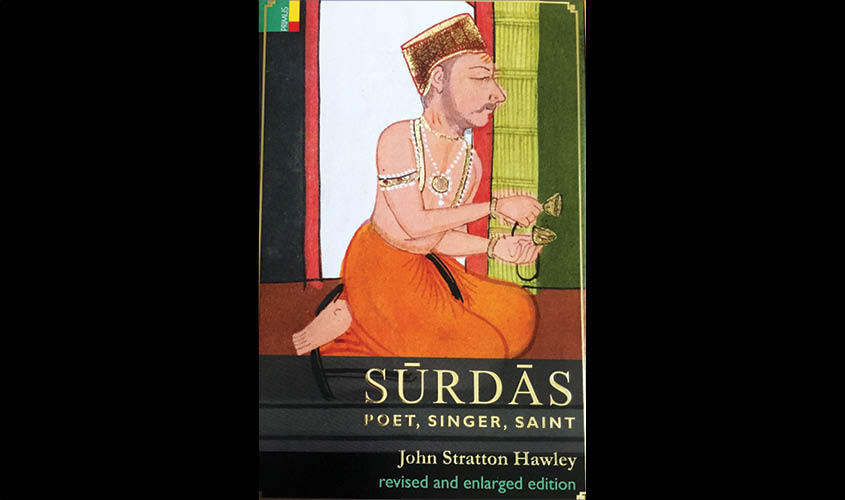Professor John Stratton Hawley is one of the foremost scholars of leading Sants of north Indian Bhakti traditions (circa 1450-1650), especially of Surdas, the 16th-century poet and singer and Krishna devotee par excellence. Professor Hawley has recently published a revised version of his book, Surdas: Poet, Singer, Saint (Primus Books). The monograph includes a 100 page chapter based on visual material from late-17th and early-18th-century Udaipur. There Surdas is shown to be a blind poet devoted to Krishna. By contrast, the Sant’s compositions that circulated without illustrations in the 16th and early 17th centuries had an extraordinary range, transcending the usual saguna/nirguna divide in Bhakti movements. There we hear nothing of Surdas being blind from birth. Rather, we encounter someone who has seen it all.
As Professor Hawley writes, “sagunis worship God through his appearance and attributes, through his manifest form, as in the insistence on experiencing Krishna in his full earthly form”, or in the worship of Sri Ram of Ayodhya by Tulsidas (author of Ramcharit-manas). By contrast “the nirguni position holds that God can truly be worshipped only in the absence of attribute and form”. This approach of Bhakti saints mainly coming from low-caste backgrounds attacks injustices and hierarchy in society, criticises idol-worship – especially discriminatory control over rituals – and, therefore, recommends searching for a formless God, which might be found inside one’s heart also.
Some of the saint-poets attempted reconciliation between the two positions. According to Hawley, Surdas’ writings show clear attempts at crossing boundaries: “chant the name of Ram if you must, ram naam mukh let, or remember Krishna, hari hari hari hari sumiran karau”. Surdas would call himself a sinner, hoping for salvation:
Patitni mayen vikhyat patit haun, paavan naam tumharau
I am a notorious sinner among the sinners
You are known as the saviour
Professor Hawley has also published, with Professor Kenneth Bryant, the English translation of a new edition of what later came to be called the Sursagar, separating poems found in earliest manuscripts form those that were evidently composed later. This volume has been published as part of the very impressive Murty Classical Library of India series edited by Professor Sheldon Pollock.
For further dissemination of state of the art scholarship on Bhakti traditions, Professor Hawley’s classic work on “three Bhakti voices” – Mirabai, Surdas and Kabir – has just been published in somewhat shortened Hindi translation by Rajkamal Prakashan. Professor Hawley has also recently published another award-winning book on the politics and historiography of Bhakti, bringing the narrative down to our difficult times, A Storm of Songs: India and the Idea of the Bhakti Movement (Harvard University Press). Together, the Sants, along with Sufis like the Chishtis, are central to the making of India’s national culture of unity in diversity – enabling peaceful coexistence amidst amazing plurality of religious traditions and practices.
The Sufi-Bhakti complex remains a crucial marker of India’s devotional tradition and cultural diversity, with all the competitions, appropriations and distinctiveness as separate and overlapping strands of popular religiosity. In regard to this the political domain must maintain a respectful equidistance. Yet, if God is one and is the creator of everything, how are the wily politicians able to make people fight with and kill each other, often in the name of religion itself? An outstanding feature of religious movements has been aimed at uniting the people, but as religious communities take the forms of sparring sampradays, panths and firqas, they necessarily exclude and otherise people. Political vultures feed and thrive on these difficulties.
Thus, Bhakti could be understood as an expression of love, devotion and sharing; it could also be comprehended as emotional songs of powerful social protest; and it can be a language of violent politics as well. In the times in which we live, we need Bhakti to be instead a unifying movement, as a matter of the heart that rises above divisive politics of various kinds. Scholars have been showing the way; can politicians behave responsibly?
A number of other scholars have also contributed immensely to multidimensional Bhakti historiography in recent decades. Besides Professor Hawley’s excellent work, one may look out for the formidable scholarship of Charlotte Vaudeville, David Lorenzen, Linda Hess, Philip Lutgendorf, Purushottam Agarwal, and more recently Christian Lee Novetzke. Together, all of them have aimed at understanding emotional expression of love for the divine in broader Hindu traditions, which in some contexts gets transformed into a violent language of politics, unfortunately.
To slightly paraphrase Professor Hawley in a recent essay, “The garland of Bhakti mediates across boundary-markers – intellectual and emotional, classical and vernacular, regional and national, powerful and weak. It stands in the middle of much of the life of religion in India and elsewhere. It may not cover the waterfront, but truly it does bridge”.

